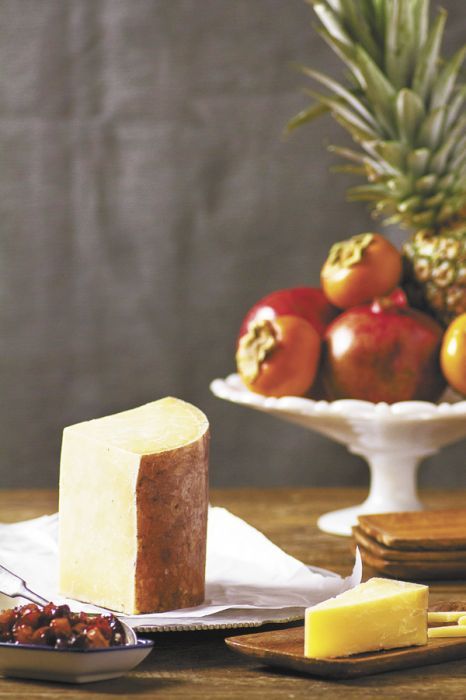Clothbound for Greatness
Dress up your holiday cheese plate with artisan cheddar

By Christine Hyatt
During the holidays, I enjoy cheeses that bring the “wow” factor and invite a bit of conversation. My favorite way to do this: Choose one perfect cheese and make sure it’s a visual sensation with an equally powerful flavor statement.
Served alongside a selection of accompaniments like homemade chutney, seasonal fruits and nuts, it becomes a memorable focal point for guests to gather round and sample something new.
Over the years, I have come to appreciate the “remember that time when we had that cheese…” conversations taking place, sometimes years later. It’s a small victory for me when I can place and identify the cheese.
My go-to cheese this year is a gorgeous hunk of clothbound cheddar. I love the rustic and intriguing look, complex, balanced flavor and wide appeal. It is as rugged as it looks and will stand up to a three-hour party, though I’ve rarely seen my platter last that long. It also has a great story.
Cheddar cheese runs the gamut from the “get-r-done” mild cheddar on the deli sandwich through two-year-old cave-aged specimens that can be studied and profiled like fine wine. It’s a ubiquitous cheese, with many facets and a fascinating history.
Cheddar was brought to the New England colonies from it birthplace, England. At the time, cheese was made by colonists in homes and on farms. It was quickly embraced as the pre-eminent cheese of the era due to its sturdy temperament and capacity for lengthy storage.
By 1790, colonial cheddar production was so prolific that it was exported back to Britain at bargain basement prices. The cheese was of such marginal quality that the upper crust sneered at that horrible “American Cheese,” a moniker of low merit persisting through the modern era.
Another cheddar game-changer was the first cheese factory started by Jesse Williams in Oneida, New York, in May 1851. It was Williams’ idea to pool milk from local dairies at a cheese factory with a skillful cheesemaker.
This model was quickly copied in American dairies and abroad. By 1869, there were more than 1,100 cheese factories in the country. By 1881, 30 years after Willams’ first factory opened, cheese production on the farm virtually ceased.
After the invention of processed cheese in 1911, and its explosive growth due to the particular marketing genius of J.L. Kraft in the teens and ’20s, natural cheddar began a decline.
The shelf-stable nature and value price of processed cheese made it a boon during the Depression, wartime and rationing. All but a few independent dairies were consolidated under the Kraft brand, with Cabot and Tillamook cooperatives two notable exceptions that continue to make fine cheese today.
In the last few decades, cheddar has re-emerged as a specialty cheese with genuine character, complexity and status. Whether a wax-coated one-year-old or two-year-old aged wheel or 40-pound blocks, cheddar has again become distinguished.
Nowhere is this more evident than in the clothbound category that has become quite the sensation in recent years at cheese counters and on award podiums. In the late ’90s, when I began my life in cheese, tasting my first clothbound was a revelation.
Montgomery’s Cheddar and Keen’s Cheddar, two traditional cheeses made for centuries in Somerset, England, literally rocked my world. It was an honor to unwrap, cut and sell these magnificent 35-pound wheels, and they looked amazing in our upright cases, all packed together in an eye-catching display of rusticity.
Knowing I was keeping alive this traditional way of farming and food production was one of the things that kept me behind the counter before it was cool.
Witnessing the transition of fine cheese defined as primarily imported to a world where American cheeses and cheesemakers more than hold their own on the world stage has been one of the most fascinating aspects of this journey.
Whether you choose an American specimen or an imported variety for your centerpiece, you are sure to please. Place on a large platter with complementary sweet and savory items and you will undoubtedly wow your holiday guests.








